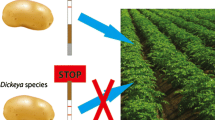Summary
Potato stems and tubers grown in the field from seed tubers inoculated withClavibacter michiganensis subsp.sepedonicus, which causes bacterial ring rot, were tested by indirect, sandwich enzyme-linked immunosorbent assay (ELISA) in five laboratories. Correlation between values for each experimental treatment from the five laboratories was greater (r=0.86) than correlation between values for individual samples (r=0.71). When three or more laboratories obtained ELISA values of ≥0.200 for a sample, that sample was presumed to be positive. Conversely, when three or more laboratories obtained ELISA values <0.200, the consensus determination was regarded as negative. The percentage of stem and tuber samples that were in agreement with the consensus ELISA determination varied from 65.5 to 96.7%. Indirect immunofluorescence tests, conducted on the same samples in two laboratories, were consistent with 83.4–91.9% of the consensus ELISA determinations. Presence or absence ofC.m. sepedonicus was confirmed in some samples by an eggplant bioassay and direct isolatiion of the bacterium. The ELISA procedure was well suited for screening large numbers of samples and this study confirms it to be a promising procedure in routine indexing of seed potatoes forC.m. sepedonicus.
Similar content being viewed by others
References
Anonymous, 1987. Scheme for the detection and diagnosis of the ring rot bacteriumCorynebacterium sepedonicum in batches of potato tubers. EUR 11288. Office for Official Publications of the European Communities, Luxembourg, 21 pp.
Corbière, R., L. Hingand & B. Jouan, 1987. Application des méthodes ELISA et immunofluorescence pour la détection deCorynebacterium sepedonicum: réponses variétales de la pomme de terre au flétrissement bactérien.Potato Research 30: 539–549.
De Boer, S.H. & J.W. Hall, 1988. An automated microscope system for estimating the population ofCorynebacterium sepedonicum cells labelled with monoclonal antibodies in immunofluorescence.Canadian Journal of Microbiology 10: 215–220.
De Boer, S.H. & M. McCann, 1990. Detection ofCorynebacterium sepedonicum in potato cultivars with different propensities to express ring rot symptoms.American Potato Journal 67: 685–694.
De Boer, S.H., A. Wieczorek & A. Kummer, 1988. An ELISA test for bacterial ring rot of potato with a new monoclonal antibody.Plant Disease 72: 874–878.
De Boer, S.H., J.D. Janse, D. Stead, J. Van Vaerenbergh & A.R. McKenzie, 1992. Detection ofClavibacter michiganensis subsp.sepedonicus in potato stems and tubers grown from seed peices with various levels of inoculum.Potato Research 35: 207–216.
Gudmestad, N.C., D. Baer & C.J. Kurowski, 1991. Validating immunoassay test, performance in the detection ofCorynebacterium sepedonicum during the growing season.Phytopathology 81: 475–480.
Janse, J.D. & J. Van Vaerenbergh, 1987. Interpretation of the EC method for the detection of latentCorynebacterium sepedonicum infections in potato.European Plant Protection Organization Bulletin 17: 1–10.
Lelliott, R.A. & P.W. Sellar, 1976. The detection of latent ring rot (Corynebacterium sepedonicum (Spieck. et Kotth.) Skapt. et Burkh.) in potato stocks.European Plant Protection Organization Bulletin 6: 101–106.
Olsson, K., 1976. Experience, of ring rot caused byCorynebacterium sepedonicum (Spieck. et Kotth.) Skapt. et Burkh. in Sweden. Particularly detection of the disease in its latent form.European Plant Protection Organization Bulletin 6: 209–219.
Persson, P. & J.D. Janse, 1988. Ring rot-like symptoms inSolanum melongena caused byErwinia chrysanthemi (potato strain) after artificial inoculation.European Plant Protection Organization Bulletin 18: 575–578.
Saettler, A.W., N.W. Schaad & D.A. Roth, 1989. Detection of bacteria in seed and other planting material. American Phytopathological Society Press. St. Paul, Minnesota, 122 pp.
Samson, R. & F. Poutier, 1979. Comparaison de trois methodes d'identification deCorynebacterium sepedonicum dans les tuberules de pomme de terre.Potato Research 22: 133–147.
Zeller, W. & Y. Xie, 1985. Studies on the diagnosis of bacterial ring rot of potatoes. I. Pathogenicity test on eggplants.Phytopathologische Zeitschrift 112: 198–206.
Zielke, R. & I. Kalinina, 1988. Ein Beitrag zum Nachweis vonClavibacter michiganensis subsp.sepedonicus (Spieckermann & Kotthoff) Davis et al. im Pflanzengewebe mit dem Mikroliter-ELISA-Verfahren.Zentralblatt für Mikrobiologie 143: 5–16.
Author information
Authors and Affiliations
Rights and permissions
About this article
Cite this article
De Boer, S.H., Van Vaerenbergh, J., Stead, D.E. et al. A comparative study in five laboratories on detection ofClavibacter michiganensis subsp.sepedonicus in potato stems and tubers. Potato Res 35, 217–226 (1992). https://doi.org/10.1007/BF02357618
Accepted:
Issue Date:
DOI: https://doi.org/10.1007/BF02357618




